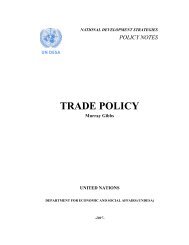Best Policy Practices
Best Policy Practices
Best Policy Practices
Create successful ePaper yourself
Turn your PDF publications into a flip-book with our unique Google optimized e-Paper software.
<strong>Best</strong> <strong>Policy</strong> <strong>Practices</strong><br />
A Clearinghouse of Ideas<br />
User’s guide<br />
Of all energy, almost 40% is consumed in buildings. Transport<br />
takes some 20% and industry the rest. You can argue the<br />
accuracy of the figures, but taken as a whole, the use and<br />
maintenance of buildings (heating, cooling, lighting, equipment)<br />
is the single biggest consumer of energy. It is shocking<br />
to see how much energy is spent on cooling and lighting<br />
alone. – The proportions may differ from one country and<br />
continent to the other, but the main message remains the<br />
same: buildings can be an energy and climate hazard – or one<br />
of the solutions in combating climate change.<br />
The best way to learn is from one’s peers: government<br />
to government, city to city. We can borrow and steal inspiring<br />
practices, processes and policies from our colleagues. This is<br />
the simple purpose of this publication, which is meant to be<br />
the kernel of an open clearinghouse in the future.<br />
<strong>Best</strong> <strong>Policy</strong> <strong>Practices</strong> – why not simply best practices?<br />
We are focussing on the potential of the public sector now,<br />
even if we are acutely aware of the vast range of stakeholders<br />
involved in the process of constructing the built environment.<br />
The public sector has several roles: it can regulate, give<br />
guidelines, collect taxes, set an example as a client and user,<br />
finance and subsidize housing and renovation, and invest in<br />
research and development – among other things.<br />
The mini-cases – some very short, others with a bit more<br />
information and links – have been grouped under twelve headlines,<br />
each essential from our point of view, even if many of the<br />
stories would fit into several:<br />
1. New construction<br />
2. Housing<br />
3. Refurbishment of existing buildings<br />
4. Energy savings and energy efficiency<br />
5. Renewable energy sources<br />
6. National and federal policies, practices and programmes<br />
7. Local policies<br />
8. Public procurement<br />
9. Research and development<br />
10. Building certification systems<br />
For more information, see link …<br />
Marrakech Task Force on Sustainable Buildings and Construction<br />
– who are we?
















